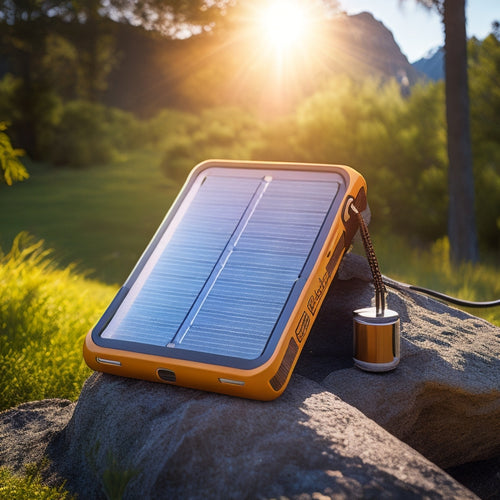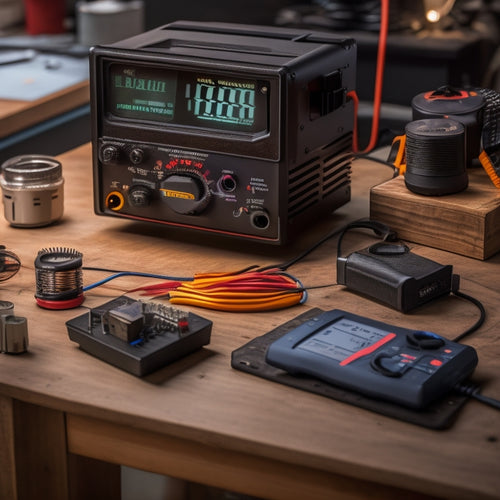
Factors Affecting Battery Life Expectancy in Homes
Share
You're likely aware that your home battery's lifespan depends on various factors, but did you know that environmental conditions, such as temperature fluctuations and humidity levels, can greatly impact its performance? The configuration of your solar panel system, including panel orientation and inverter efficiency, also plays an essential role. Additionally, the type and quality of your battery, as well as your charging and maintenance habits, can affect its longevity. Even the depth of discharge and cycling frequency can influence its lifespan. By understanding these factors, you can take steps to optimize your battery's performance and extend its life, and there's more to investigate on how to do just that.
Overview
- Temperature fluctuations, humidity levels, and ventilation quality significantly impact battery lifespan, with ideal conditions ranging from 20°C to 30°C and low humidity.
- The type and quality of battery used, such as lithium-ion, lead-acid, or flow batteries, affects its lifespan and overall system efficiency.
- Charging and maintenance habits, including monitoring health, avoiding overcharging, and regular inspections, play a crucial role in prolonging battery life.
- Depth of discharge and cycling frequency, with optimal levels being 20-50% DoD and 300-500 cycles, significantly influence battery lifespan and overall system efficiency.
- Installation location, solar panel system configuration, and energy harvesting strategies also impact battery life expectancy in homes.
Environmental Factors at Play
Environmental Factors at Play
When you install a battery in your home, you need to take into account the environmental factors that affect its performance and lifespan. Temperature fluctuations, for instance, can greatly impact your battery's health. Extreme temperatures can cause degradation, reducing its overall capacity.
Ideal operating temperatures range from 20°C to 30°C ideal operating temperatures, and deviations from this range can accelerate degradation. You should also monitor humidity levels, as high moisture can lead to corrosion and shorten the battery's lifespan.
Additionally, ventilation quality is vital, as poor airflow can cause heat buildup and accelerate degradation. The installation location is also important, as seasonal variations can affect the battery's performance.
Exposure duration to these factors adds up, so it's important to evaluate these environmental factors to guarantee peak battery performance and extend its lifespan.
Solar Panel System Configuration
Set up your solar panel system to maximize energy harvesting and battery charging. Proper panel orientation is essential, as it directly affects the amount of energy generated.
Ideally, panels should face south and be tilted at an angle between 30° and 40° to capture the most sunlight. Considerations such as grid connection and ideal site selection can also enhance energy production.
Additionally, consider inverter efficiency, which can greatly impact your system's overall performance. Look for inverters with high efficiency ratings (>95%) to minimize energy loss.
A well-configured solar panel system will guarantee your batteries are charged efficiently, leading to a longer lifespan. By optimizing your system, you'll be able to store more energy and enjoy greater freedom from the grid.
Battery Type and Quality Matters
Frequently, homeowners overlook the significance of battery type and quality when designing their solar panel system, leading to subpar performance and reduced lifespan. You must consider the battery chemistry, as it plays an essential role in determining the battery's overall performance and lifespan. Lithium-ion batteries, for instance, are known for their high energy density and long lifespan.
| Battery Type | Brand Reputation | Lifespan |
|---|---|---|
| Lithium-Ion | High (e.g., Tesla) | 10-15 years |
| Lead-Acid | Medium (e.g., Rolls-Surrette) | 5-7 years |
| Nickel-Cadmium | Low (e.g., Saft) | 5-10 years |
| Flow Battery | High (e.g., vanadium redox) | 10-20 years |
| Sodium-Ion | Emerging (e.g., Faradion) | 5-10 years |
When selecting a battery, consider the brand reputation, as it often reflects the quality of the battery. A reputable brand guarantees that you get a high-quality battery that will meet your energy needs efficiently.
Charging and Maintenance Habits
Proper charging and maintenance habits are crucial to extending the lifespan of your batteries. You can't just charge your batteries and forget about them; you need to monitor their health and adjust your charging frequency accordingly. Overcharging can cause damage, so it's essential to keep an eye on the charging status.
Regular water level checks and cleaning of terminals and connections can prevent electrical resistance and heat buildup. Developing regular maintenance routines helps identify potential issues before they become major problems. For instance, checking the battery terminals for corrosion and ensuring proper ventilation can prevent overheating.
Depth of Discharge and Cycling
You've taken the first step in maximizing your battery's lifespan by adopting good charging and maintenance habits. Now, let's explore the impact of depth of discharge and cycling on your battery's life expectancy. Depth of discharge refers to the percentage of the battery's capacity that's used before recharging. Cycling frequency, on the other hand, is the number of charge and discharge cycles a battery goes through.
| Depth of Discharge | Impact on Battery Life |
|---|---|
| 20% | Minimal impact, ideal for daily use |
| 50% | Moderate impact, suitable for occasional heavy loads |
| 80% | Significant impact, avoid frequent deep discharges |
| 100% | Maximal impact, avoid full discharges whenever possible |
| Varies | Cycling frequency affects lifespan, aim for 300-500 cycles |
Understanding the relationship between discharge rates and cycling frequency is vital in prolonging your battery's lifespan. By keeping track of these factors, you can optimize your energy storage system for maximum efficiency and freedom.
Frequently Asked Questions
Can Batteries Be Recycled or Repurposed at the End of Their Life?
When you're done with your batteries, you can recycle or repurpose them to minimize battery disposal, reducing the environmental impact of toxic chemicals and conserving natural resources, ultimately giving you freedom from waste and pollution.
How Do Smart Home Devices Impact Battery Life Expectancy?
You'll find that smart home devices can greatly impact battery life expectancy, as they often prioritize convenience over smart device efficiency, leading to increased power consumption trends that drain your batteries faster than you'd like.
Can I Use a Generator to Charge My Battery System?
You're wondering if a generator can charge your battery system; theoretically, it's possible, but you'll need to guarantee generator compatibility and ideal charging efficiency to avoid damaging your batteries or reducing their lifespan.
Do Battery Warranties Cover Decreased Capacity Over Time?
You'll find that battery warranties typically cover capacity degradation up to a certain percentage, but you'll need to review the warranty terms to understand the specifics, as they vary between manufacturers and models.
Can I Upgrade My Existing Battery System to a Newer Model?
You can upgrade your existing battery system to a newer model if you verify battery compatibility and consider installation challenges, such as rewiring or recalibrating your system, to guarantee seamless integration and peak performance.
Ready to Buy
As you weigh the factors affecting battery life expectancy in your home, remember that every detail counts. Did you know that a staggering 70% of battery failures are attributed to poor maintenance and charging habits? By optimizing your solar panel system configuration, choosing high-quality batteries, and adopting smart charging practices, you can access the full potential of your energy storage system and maximize its lifespan.
Related Posts
-

Why Outdoor Solar Lighting Systems Are Sustainable
Outdoor solar lighting systems are sustainable because they utilize renewable energy, drastically reducing your carbo...
-

Fastest Solar Chargers for Emergency Power
When choosing the fastest solar chargers for emergency power, you need to focus on features like rapid charging capab...
-

Key Features of a DC to AC Converter
A DC to AC converter features high efficiency and conversion rates, which reduce energy costs and improve performance...


